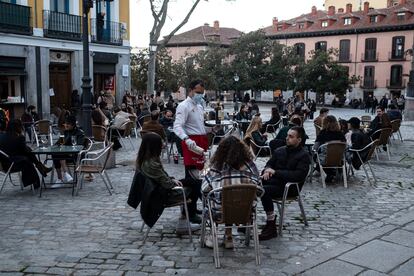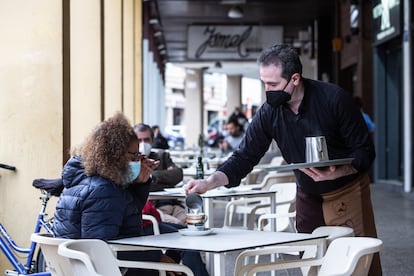Spain’s regions move to ease coronavirus restrictions despite high contagion rates
Several territories, such as Madrid, are relaxing measures, even though the incidence level nationwide remains above 250 cases per 100,000 inhabitants, considered to indicate a situation of “extreme risk”


Coronavirus infections continue to fall in Spain, but the country is still far from getting the pandemic under control. The peak of the third wave of the health crisis is now over, but while new cases and hospital admissions are falling, there is still a high level of pressure on the country’s healthcare systems – a total of 3,822 Covid-19 patients are currently receiving treatment in intensive care units (ICUs).
In its daily report released on Thursday, the Health Ministry reported 14,515 new coronavirus cases and added 388 fatalities to the death toll. The 14-day cumulative number of infections per 100,000 inhabitants has now fallen to 321, but this is still above the extreme risk level of 250 established by the Spanish government.
Speaking on Thursday evening to present the latest data, Fernando Simón, the director of the Health Ministry’s Coordination Center for Health Alerts (CCAES), called on citizens not to drop their guard, but some of the country’s regions have already started to roll back their social restrictions. Since yesterday, the Madrid region has changed its curfew time from 10pm to 11pm, and is allowing bars and restaurants to stay open until the same time (until Thursday they had to close at 9pm). Castilla y León, for its part, will be lifting the perimetral lockdown of some of its provinces, while Aragón will be suspending the confinement of the cities of Zaragoza and Calatayud. The experts, meanwhile, are calling for caution with these deescalation measures and have warned about the spread of the more contagious strain of the coronavirus first identified in the United Kingdom.

While the downward trend of the epidemiological data is positive, Spain is far from having the spread of the virus under control. Only seven regions – the Canary and Balearic islands, Cantabria, Extremadura, Murcia, Navarre and La Rioja are below the extreme risk level of 250 cases per 100,000 inhabitants. Simón warned last night that even these regions are in a “very bad” situation.
The pressure on the country’s hospitals, meanwhile, persists, with 35% of ICUs occupied by Covid patients. “They are still very high figures that are stopping us from loosening the measures more than we should, because if there is a new spike the occupation level will be too high for the system to take,” Simón explained.
Spain’s regions have employed a range of different restrictions to deal with the third wave of the pandemic, and some of those in the worst situation have not necessarily implemented the strictest measures. Navarre, for example, closed the inside of bars on January 23 with a cumulative incidence that exceeded 400 cases per 100,000 inhabitants over 14 days. Madrid, meanwhile, which doubled that rate, left them open with capacity restrictions of 50% inside and 75% outside.
If there is a new spike the occupation level in ICUs will be too high for the system to takeFernando Simón, director of the Health Ministry’s Coordination Center for Health Alerts
“In the third wave the descent has been very fast, but it is also true that it has been more evident in regions where tougher measures have been taken,” explained Health Minister Carolina Darias on Thursday during a commission hearing in the Congress of Deputies, Spain’s lower house of parliament. Darias called for the regions to take great care in order to lower the incidence rate to below 50 cases per 100,000 inhabitants – the target the Health Ministry considers would see the pandemic under control. “We have to be very cautious and the cumulative incidence is above the level of maximum risk,” she continued. “We must continue with the restrictions, we cannot let our guard down. The new variants are lurking and I call for all of the regions to maintain the measures.”
“Regions such as Madrid, Extremadura and Castilla-La Mancha are opting for relaxation and are committing a fatal mistake because this will lead to an intensification of transmission, a slowdown of the fall in the curve and the continuation of high pressure [on hospitals],” said Daniel López-Acuña, a former director of emergencies at the World Health Organization (WHO).

As well as the change in curfew times and bar opening hours, Madrid has also increased the number of diners permitted on street cafés from four to six, despite having the highest cumulative incidence in Spain, at 457 cases per 100,000 inhabitants over the last 14 days – only behind the North African city of Melilla.
Other regions that had implemented a de facto lockdown are also lifting their measures. La Rioja, for example, will suspend its perimetral lockdown from Monday and will permit non-essential activity to restart. Galicia, meanwhile, has announced a gradual deescalation, and stores will soon be able to stay open until 9pm instead of 6pm. The hostelry sector, meanwhile, will remain closed.
“We are in a very dangerous phase, one that we already saw at the end of November,” explained Alberto Infante, emeritus professor of international health at Madrid’s Carlos III Institute. “The thinking is that because the trend is good, the situation is good. And that is not the case. By confusing the two things, the pressure to deescalate is going to be huge and this will happen in the next two weeks, which are a key time to see what happens with the British variant. It’s a delicate time, above all else if we let ourselves get carried away.”
The thinking is that because the trend is good, the situation is good. And that is not the caseAlberto Infante, emeritus professor of international health at Madrid’s Carlos III Institute
The progress of the British variant of the virus, which has been confirmed in 613 cases in Spain, could affect the trend, and once again endanger the country’s health system. “In December the Constitution Day public holiday and the Black Friday sales were enough for the curve to change trend,” Infante warned. “And at that time we didn’t have the threat of the British variant and the incidence was 190 cases per 100,000 inhabitants, while at the moment it is 300.”
The true presence of the British variant in Spain is still unknown, but the Health Ministry has estimated that it is behind 20% of infections and could play an important role in an eventual uptick of the epidemiological curve. “We are seeing this in Catalonia,” said López-Acuña. “By introducing a higher infectivity, the downward trend of the curve could slow.” In fact, the Catalan regional government is planning to put the brakes on its deescalation plan given the slowdown in the fall of new cases. “The [British] variant is no doubt more widespread, it’s just that we don’t know by how much, how it is growing, and where it is more common,” said Infante. “We are still in the dark with this variant. A system of surveillance should have been put in place to measure its progression.”
The experts have also warned that the vaccination campaign, which has so far seen a million people in Spain receive the two doses necessary to offer the maximum protection, is yet to reach a level where its effect is reflected in the epidemiological curve. That said, in senior residences, where the inoculation program is nearly complete, outbreaks have fallen by half in 15 days, and the regions are reporting a reduction in contagion and serious illness. “We need to be prudent during four to six weeks,” said Benito Almirante, the head of infectious diseases at the Hospital Vall d’Hebron in Barcelona. “If the number of ICU patients does not improve substantially, it would not be appropriate to relax the restrictions. If we manage to vaccinate more than 15% of the population we could start to lift mobility restrictions, but right now we are far from a minimum level of protection.”
Above all, the experts consulted insisted, the transmission of the virus is still too high and that will translate into many hospital admissions and eventual deaths. “We have normalized the tragedy,” Infante warned. “We see 300 [daily] deaths as a good thing because we have had as many as 700, but this is not normal. And it could be that what we see soon is not a big uptick in cases, but rather that they persist over time and end up not falling. And that will lead to more deaths,” he concluded.
English version by Simon Hunter.
Tu suscripción se está usando en otro dispositivo
¿Quieres añadir otro usuario a tu suscripción?
Si continúas leyendo en este dispositivo, no se podrá leer en el otro.
FlechaTu suscripción se está usando en otro dispositivo y solo puedes acceder a EL PAÍS desde un dispositivo a la vez.
Si quieres compartir tu cuenta, cambia tu suscripción a la modalidad Premium, así podrás añadir otro usuario. Cada uno accederá con su propia cuenta de email, lo que os permitirá personalizar vuestra experiencia en EL PAÍS.
¿Tienes una suscripción de empresa? Accede aquí para contratar más cuentas.
En el caso de no saber quién está usando tu cuenta, te recomendamos cambiar tu contraseña aquí.
Si decides continuar compartiendo tu cuenta, este mensaje se mostrará en tu dispositivo y en el de la otra persona que está usando tu cuenta de forma indefinida, afectando a tu experiencia de lectura. Puedes consultar aquí los términos y condiciones de la suscripción digital.
More information
Últimas noticias
Most viewed
- Reinhard Genzel, Nobel laureate in physics: ‘One-minute videos will never give you the truth’
- Oona Chaplin: ‘I told James Cameron that I was living in a treehouse and starting a permaculture project with a friend’
- Pablo Escobar’s hippos: A serious environmental problem, 40 years on
- Why we lost the habit of sleeping in two segments and how that changed our sense of time
- Chevy Chase, the beloved comedian who was a monster off camera: ‘Not everyone hated him, just the people who’ve worked with him’










































